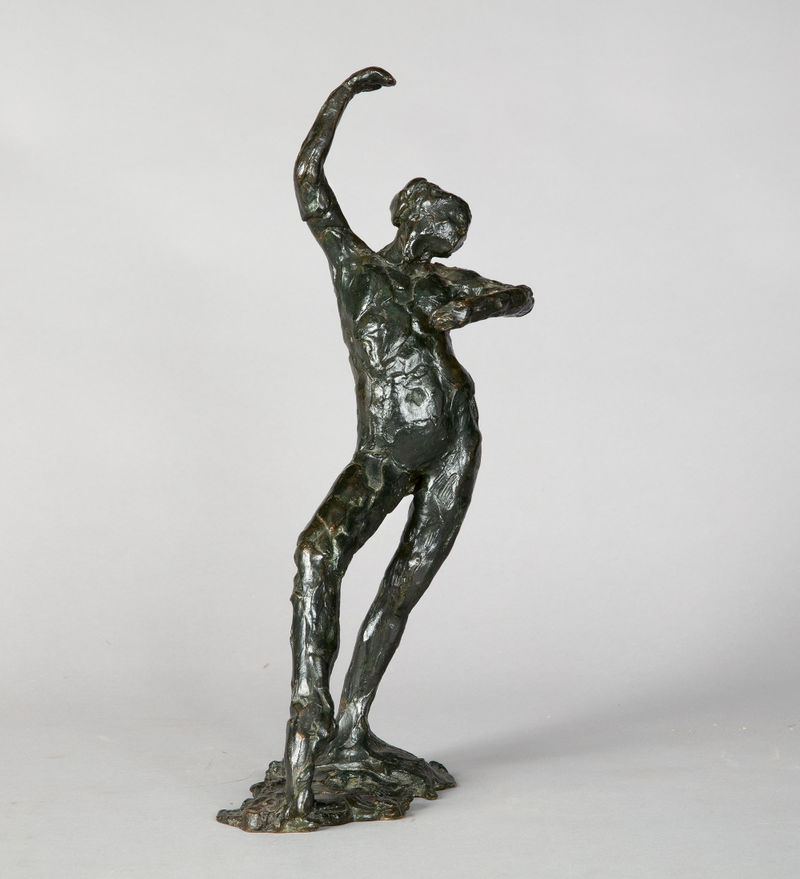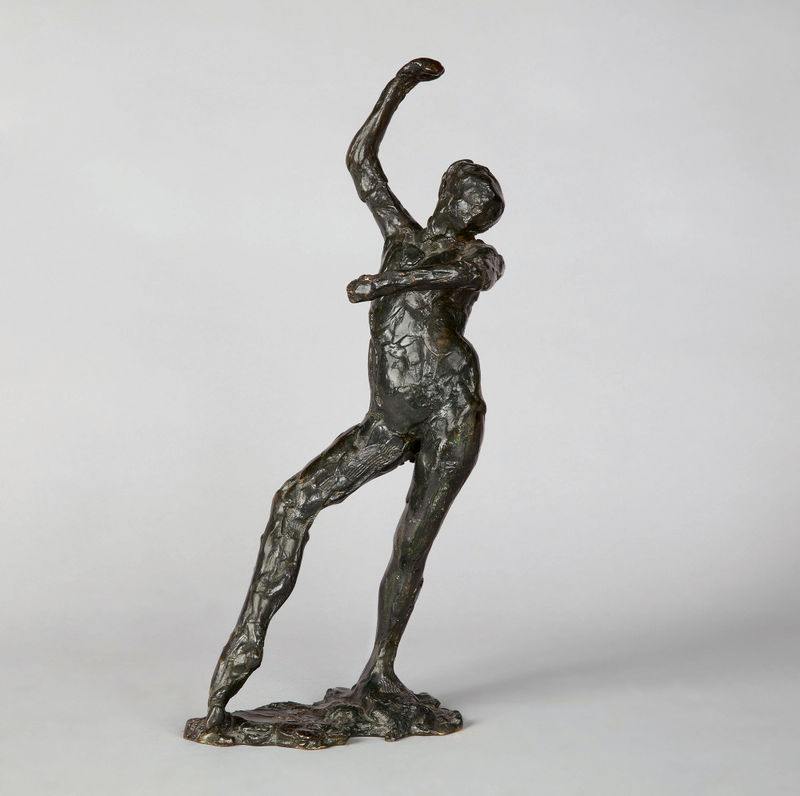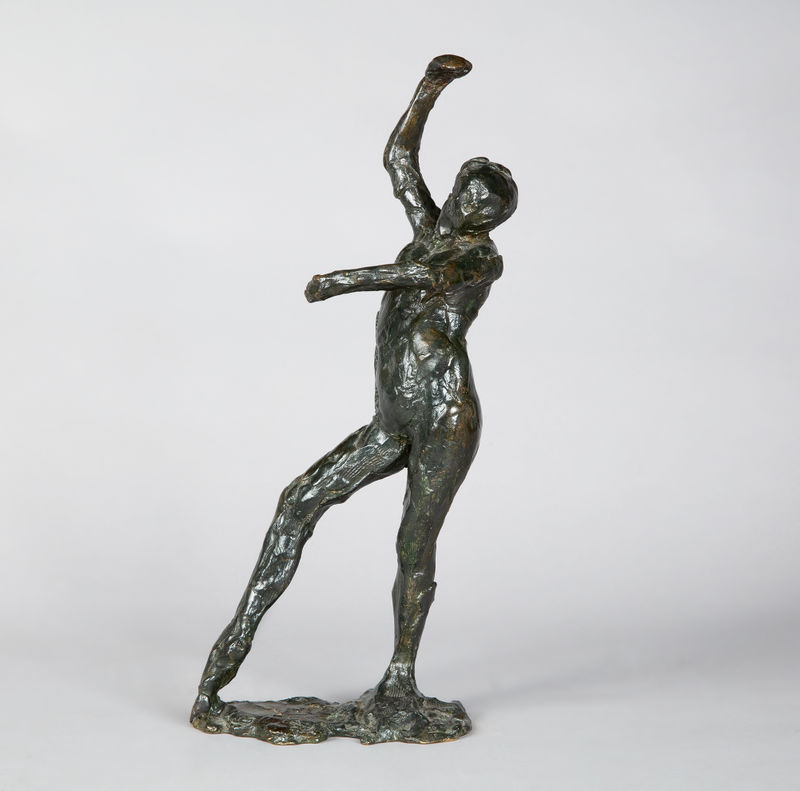Edgar Degas
(French, 1834-1917)
Danse espagnole
conceived c.1885; cast after 1919 in an edition of 20, numbered A to T plus casts reserved for the Degas heirs (marked HER.D and HER), by the A. A. Hébrard Foundry, Paris
bronze
height: 41.3 cm (16¼ in.)
stamped ‘Degas’, numbered ‘20/F’ and with the foundry mark ‘A. A. Hébrard Cire Perdue’
Galerie Beyeler, Basel (by 1953)
Galerie Georges Moos, Paris
M. Knoedler & Co., New York (1955)
Mrs. Allen Manus, Ontario (May 1956)
Private collection, New Jersey
Richard L. Feigen & Co., New York (11 November 1985)
Robert T. Carmel, New York (1985)
Sale: Christie's New York, 13 November 1996, lot 28
Ezra & Cecile Zilkha, New York (acquired at the above sale)
J. Rewald, Degas, Works in Sculpture, A Complete Catalogue, New York, 1944, pp. 27 & 130, no. LXVI (another cast illustrated)
L. Browse, Degas Dancers, Boston, 1949, no. 154 (another cast illustrated)
J. Rewald & L. Von Matt, Degas Sculpture, The Complete Works, Zurich, 1956, pl.46, no. XLVII (another cast illustrated)
P. Cabanne, Edgar Degas, Paris, 1959, p. 61 (another cast illustrated)
F. Russoli & F. Minervino, L'opera completa di Degas, Milan, 1970, p. 141, no. S16 (titled Danzatrice spagnola, another cast illustrated)
C. W. Millard, The Sculpture of Edgar Degas, Princeton, 1976, no. 69 (another cast illustrated)
J. & M. Guillaud, Degas, Form and Space, Paris, 1984, no. 180 (titled Spanish Dance, another cast illustrated)
R. Gordon & A. Forge, Degas, New York, 1988, pp. 209 & 278 (another cast illustrated)
J. Rewald, Degas's Complete Sculpture, Catalogue raisonné, San Francisco, 1990, pp. 170-71, no. LXVI (titled Spanish Dance, wax version and another cast illustrated)
A. Pingeot, Degas Sculptures, Paris, 1991, p. 160, no. 16 (another cast illustrated)
S. Campbell, "Degas, The Sculptures, A Catalogue Raisonné," in Apollo, vol. CXLII, no. 402, August, 1995, pp. 20-21, no. 20 (titled Spanish dance, another cast illustrated)
J. S. Czestochowski & A. Pingeot, Degas Sculptures, Catalogue raisonné of the Bronzes, Memphis, 2002, pp. 160-61, no. 20 (titled Spanish Dance, another cast illustrated)
S. Campbell, R. Kendall, D. Barbour & S. Sturman, Degas in the Norton Simon Museum, vol.II, Pasadena, 2009, pp. 298-99 & 300, no. 51 (titled Spanish dance, another cast illustrated)
S. G. Lindsay, D. S. Barbour & S. G. Sturman, Edgar Degas Sculpture, Washington DC, 2010, pp. 156-161 & 369, no. 20 (titled Spanish Dance, wax version illustrated)
Paris, Galerie A. A. Hébrard, Exposition des sculptures de Degas, 1921, no. 16
New York, The Grolier Club, Prints, Drawings and Bronzes by Degas, 1922, no. 73
Basel, Galerie Beyeler, Tableaux français, 1953, no. 33 (illustrated)
The fervent exploration of movement is a defining feature of the oeuvre of Edgar Degas, and nowhere is his exceptional aptitude for representing the human form in motion more evident than in his sculptures. John Rewald wrote: "It was in his passionate search for movement that all the statuettes of dancers doing arabesques, bowing, rubbing their knees, putting their stockings on, etc., and of women arranging their hair, stretching, rubbing their neck and so on were created. All these women are caught in poses which represent one single instant, in an arrested movement which is pregnant with the movement just completed and the one about to follow. To use Baudelaire's words, Degas 'loved the human body as a material harmony, as a beautiful architecture with the addition of movement'" (J. Rewald, op. cit., 1990, p. 23).
Discussing the pose of the dancer in the present work, Suzanne Glover Lindsay wrote: "This figure’s 'Spanish' pose is not easily identified with dance movements or poses in the Spanish repertory. It suggests a hybrid of French ballet and Spanish dance, with a Spanish 'feel.' The arm position resembles forms in both dance types, but the complex posture departs from the ones of classical dance... The open thumbs and curled fingers evoked by the well-articulated, fragmentary hands suggest they hold castanets... By Degas’ time, both dance types had been evolving for decades, especially in Paris, where he probably saw Spanish dance before travelling to Spain in 1889. His views of the latter probably derived from French adaptations, often inspired by Spanish troupes that began touring Europe in the 1830s to great applause, motivating European classical dancers and choreographers to appropriate elements" (S. Lindsay in S. Lindsay, D. Barbour & S. Sturman, op. cit., pp. 159-160).
Price:
$450,000 (+5% UK import VAT)
More artworks by Edgar Degas ▶
Additional Notes:
After passing through some of the most highly regarded galleries, Danse espagnole finally settled in the collection of Ezra and Cecile Zilkha(fig 2.). The Zilkha family traced its roots back to ancient Babylon, and in the 20th century they became prominent international bankers, once called the ‘Rothschilds of the Levant’.
Ezra and Cecile Zilkha’s life in New York reflected this cosmopolitan outlook and deep appreciation of and passion for history. Their apartment overlooking Central Park represented one of the last of the accomplished Fifth Avenue interiors, inspired by the classical grandeur of a Parisian hôtel particulier. It provided a perfect setting for the Zilkhas’ frequent entertaining of international diplomats, artists, politicians and businessmen and their philanthropic activities for the Metropolitan Opera and American Ballet Theater, among others. Displaying important Old Master paintings, 18th-century French and Continental furniture, objetsd’art, sculpture, silver and ceramics, alongside important Impressionist and Modern Art, this collection combines works ranging from the renowned cabinet maker André-Charles Boulle to Auguste Rodin and Edgar Degas, thereby creating a distinguished and harmonious expression across time, style and space.
The original wax model of Danse espagnole is in the National Gallery of Art, Washington, D.C.; a number of bronze casts are in international museums, including the Metropolitan Museum of Art in New York, Tate Gallery in London, Musée d’Orsay in Paris, The Art Institute of Chicago, Detroit Institute of Arts in Detroit, Ny Carlsberg Glyptotek in Copenhagen and National Gallery in Oslo.
You may also like:
Enquire Now
Fill in the form below and we will respond as soon as possible.
Make an offer
Fill in the form below and we will respond as soon as possible.



